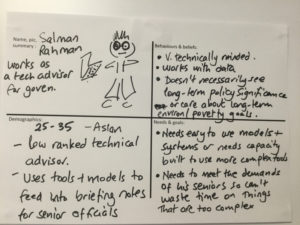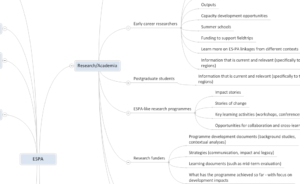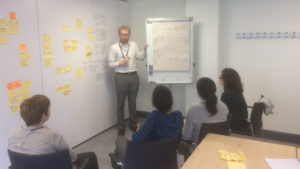Using interviews to gather insight from remote stakeholders
We were recently involved in a project to support ESPA (Ecosystem Services for Poverty Alleviation) in creating proto-personas to inform the redevelopment of their website.
ESPA is an global interdisciplinary research programme based at Research into Results, a wholly owned subsidiary of the University of Edinburgh. The programme works with a variety of stakeholders in the UK and the global south. It aims to give decision-makers and natural resource users the evidence they need to address the challenges of sustainable ecosystem management and poverty reduction.
ESPA (Ecosystems Services for Poverty Alleviation)
We were approached to support ESPA and their development partners in the IS Applications division to help them shape the priority and focus of a redevelopment of their website.
The ESPA programme is moving into a new phase, and they now need to ensure the longevity and usefulness of their resources to create a legacy for this 11 year programme. To this end, ESPA sought a means for building a consensus around who they are serving with the website and why.
Challenges of gathering insight remotely
To help build that consensus picture of who their audiences are, we held workshops to assist in the development of proto-personas.
Using proto-personas for executive alignment – UX Magazine
Four of ESPA’s key stakeholders were based in Africa and Asia. It was essential that these people were involved in the process. These people were our strongest way of gaining insight into some of ESPA’s users, who they were working with on the ground in developing countries.
It was not going to be possible to bring all the stakeholders together into one room for a workshop, as we normally would. Instead, a significant portion of our work had to be carried out remotely.
The ESPA project would have been challenging enough as it was. But the fact that the people most able to inform us about their audiences couldn’t be physically present added a further complication.
We considered using a combination of Skype and an online card-sorting tool to involve our remote stakeholders in the workshop live. But the technical challenges would have been too difficult to overcome.
Blending physical workshops with remote interviews
Instead, we interspersed the physical workshops with remote stakeholder interviews. With some careful planning and preparation, we structured these interviews so that we could feed the insight back into the workshops that were being held with Edinburgh-based stakeholders.
This meant focusing strongly on the intended outcomes of the workshop: finding out about ESPA’s key audiences and their attributes, to inform the development of proto-personas. I also asked our remote stakeholders to produce some proto-personas of their own, repeating the group exercise used in the workshop.
The programme of workshops was similar in format to one that we have previously run for Cityscope.
Collaborative planning of new user experiences for Cityscope
Feeding back the insight from the interviews
After the interviews with remote stakeholders were complete, I transcribed our notes and produced a summary of the key points. Later, I mindmapped the conversations, creating a branch for each different audience member or user need that had been highlighted by the stakeholders.
Mindmapping to improve the structure of your web content
By this time I had facilitated the first workshop, where the Edinburgh-based staff grouped and prioritised audiences. So I had gained enough knowledge about ESPA’s audiences to interpret the findings of the interviews. Considering the outputs of the first workshop along with the interviews with our four remote stakeholders, some clear trends emerged.
Taking inspiration from the findings of the first workshop, I conducted my own affinity mapping exercise of the items raised in the interviews, grouping items that seemed to fit together.
When it came to holding the second physical workshop, I was able to present the outputs of the interviews in a way that helped the group focus on who their key audiences really are, while verifying with the group that my decisions were correct.
The group then fleshed out and prioritised their proto-personas.
Externalising assumptions with Lean UX hypothesis statements
In the latter portion of the workshop, the group developed Lean UX hypothesis statements to help us think about how we could best meet our audiences’ needs. This approach helps stakeholders externalise their assumptions about what proposed features would mean for both ESPA and their target audiences.
Another reason for adopting this technique was that it enabled us prioritise features and build a backlog for the developers to take on.
A hypothesis statement takes the following format, with workshop activities designed to fill in the blanks:
We will achieve [this business outcome]
if [these audiences]
successfully attain [this user outcome]
with [this feature].
Again, by using potential answers to these blanks from the mindmap derived from the interview transcripts, we had an opportunity to plug in the insight from our remote stakeholders.
Learn more about Lean UX – requirements are hypotheses
Repeating the process to develop a fuller picture
Following the workshop, we conducted a further short round of interviews with one of the Asia-based stakeholders. This was to verify that the proto-personas felt like real people, and to validate the Lean UX hypotheses. This enabled us to further refine the personas and hypotheses, to feed into the backlog of tasks for the development of the website.
By repeating the process, we could feed insight from the stakeholders into the workshop, and in turn feed the workshop outputs back to the stakeholders in order to verify them. This way we were able to complete a fuller picture of what ESPA’s proto-personas needed to be.
We had never attempted an approach like this before, so we were not sure how successful it would be. In the end, the process worked well. By alternating between physical workshops and remote interviews, I was able to feed valuable insight back into the workshops while I facilitated them.
Nothing beats getting a representative cross-section of your team together in a room. But when that is not possible, we can turn to stakeholder interviews as an alternative means of gathering the required insight.
Contact us
If you would like support on understanding the requirements for your digital presence get in touch with us to explore the variety of techniques we can pursue.





1 replies to “Using interviews to gather insight from remote stakeholders”